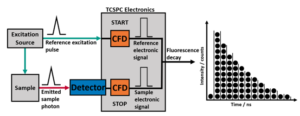Menu
Organic photofunctional co-crystals have attracted immense interest thanks to their unique properties, ranging from their high photoluminescence (PL) efficiency and flexible semiconducting functionality to their unique molecular stacking. Co-crystals have been used to develop organic light-emitting transistors (OLETs) and organic solid-state lasers (OSSLs), as well as for upconversion emission, bioimaging, and optical waveguides. The majority of the reported co-crystal structures are based on extensively planar and rigid constituents. This results in weak intermolecular interactions limiting the overall optoelectronic efficiency of the co-crystals, including charge-transfer (CT) and thermally activated delayed fluorescence (TADF).
A way to mitigate this issue is the integration of twisted aromatic hydrocarbons (TAHs) into the co-crystal structures. TAHs are organic molecules with aromatic (ring-like) structures but with a non-planar, twisted geometry. This structural feature can influence the overall crystal packing and arrangement of molecules in the co-crystal lattice. This, in turn, affects the electronic states, charge transport and optical properties of the material, resulting in, e.g., improved PL and improved photon harvesting characteristics via effective reverse intersystem crossing (RISC).
In this Research Highlight, we present the work of a team of scientists from India who recently published their findings in Nature Communications.1 The researchers developed a series of four novel TAH-based luminescent CT-co-crystals (TAHOFN, TAHTFPN-G, TAHTFPN-O, TAHTCNB), they studied their photofunctional properties and explored their potential applications to waveguiding and cellular imaging.
To study the optical properties of the co-crystals, the authors used the Edinburgh Instruments FLS-series Photoluminescence Spectrometer and the LP980 Transient Absorption Spectrometer (Figure 1). The LP980 was equipped with an iCCD camera and a PMT photodetector for spectral and temporal data acquisition, respectively. Both instruments were also equipped with a cryostat for temperature-dependent PL and transient absorption (TA) measurements.
Figure 1 Edinburgh Instruments FLS1000 Photoluminescence Spectrometer and the LP980 Transient Absorption Spectrometer.
To understand in detail the excited states of the TAH-based co-crystals, the researchers applied time-resolved photoluminescence (TRPL) spectroscopy using time-correlated single-photon counting (TCSPC), Figure 2. All samples were in powder form, and the average lifetime of the four co-crystals was in the ns regime (0.50 ns, 0.87 ns, 1.06 ns, and 38.81 ns). The lifetime decay of TAHOFN, TAHTFPN-G, and TAHTFPN-O was fitted by a single-exponential component. In contrast, the decay of TAHTCNB comprised three exponential components, suggesting the presence of prompt and delayed emissive species. The average lifetimes were then used to calculate the co-crystals’ radiation constants (kf), whose values confirmed that the origin of fluorescence of the TAH-based samples was from CT states.
Figure 2 TRPL decays of the TAH-based samples measured in TCSPC using FLS series. Figure reproduced from Nature Communications under CC by 4.0 licence.
Further investigation of the delayed emission of the TAHTCNB-based film included laser-induced fluorescence (LIF) measurements using the LP980 and an iCCD camera. In LIF, a laser excites a sample, and a photodetector can detect the emitted fluorescence at a specified time. LIF spectra were acquired at various time delays after laser excitation, from ns to µs (Figure 3a). Detection within the microsecond range corroborated the presence of TADF. The presence of TADF was further confirmed by performing TA spectroscopy using a cryostat at room temperature (RT) and 77 K (Figure 3b). At 77 K, the positive TA trace at 600 nm is significantly decreased compared to that at RT. This observation indicates that the TA trace originated via a thermal process, which was heavily suppressed at 77 K.
Figure 3 LP980 measurements on a TAHTCNB film showing a) LIF spectra at various time delays after laser excitation and b) TA spectra of the same sample at RT and 77 K. Figures reproduced from Nature Communications under CC by 4.0 licence.
Temperature-dependent PL and TRPL were performed on the same TAH-based film using the FLS-series PL Spectrometer. The difference in PL spectral intensity at RT, 200 K and 100 K was examined (Figure 4a). At the same temperatures, the average lifetimes of the delayed species were determined in the µs range (Figure 4b). Then, at 77 K, the acquisition of the phosphorescence spectrum of the TAH-based film was acquired, enabling the experimental calculation of the splitting energy (ΔEST = 0.01 eV) between the lowest singlet (S1) and triplet (T1) states of the sample (Figure 4c).2
Figure 4 a) PL spectra of the TAHTCNB film at RT, 200 K, and 100 K. b) TRPL decays of the delayed species, and c) normalised PL spectrum at RT and phosphorescence spectrum at 77 K. Figures reproduced from Nature Communications under CC by 4.0 licence.
Edinburgh Instruments’ FLS-series Photoluminescence Spectrometer and LP980 Transient Absorption spectrometer, equipped with a cryostat for temperature-dependent measurements, were used to optically characterise co-crystals which exhibited multifunctional behaviour. The researchers proposed their successful application as efficient waveguiding materials and potential implementation in biological applications, such as cell imaging and therapeutics.
The results shown in this Research Highlight were published in Nature Communications, and more details can be found here: Highly efficient color-tunable organic co-crystals unveiling polymorphism, isomerism, delayed fluorescence for optical waveguides and cell-imaging


